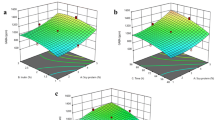Abstract
Synergistic fermentation between bacteria and fungi has great potential in many industrial fields. Here, we investigated how bacterial-fungal fermentation can promote the bioactivity of edible-fungus. The submerged Lactobacillus plantarum culture actively produced acids incorporated with polysaccharides from β-glucan-rich Pleurotus eryngii as a substrate for fermentation that resulted in a low pH of submerged culture. Fermented P. eryngii with L. plantarum showed enhanced bioactivities, including anti-bacterial, antioxidant, and anti-allergic activities compared to hot water extract of P. eryngii. This result suggests that a synergistic fermentation between bacteria and fungi can apply to functional food making.
Similar content being viewed by others
References
Tang AC, Turvey SE, Alves MP, Regamey N, Tümmler B, Hartl D. Current concepts: Host-pathogen interactions in cystic fibrosis airways disease. Eur. Respir. Rev. 133: 320–332 (2014)
Falsetta ML, Klein MI, Colonne PM, Scott-Anne K, Gregoire S, Pai C-H, Gonzalez M, Watson G, Krysan DJ, Bowen WH, Koo H. Symbiotic relationship between Streptococcus mutans and Candida albicans synergizes virulence of plaque biofilm in vivo. Infect. Immun. 82: 1968–1981 (2014)
Scott R, Sullivan WC. Ecology of fermented foods. Hum. Ecol. Rev. 15: 25–31 (2008)
Whipps JM. Microbial interactions and biocontrol in the rhizosphere. J. Exp. Bot. 52: 487–511 (2001)
Fleet GH. Yeast interactions and wine flavour. Int. J. Food Microbiol. 86: 11–22 (2003)
Frey-Klett P, Burlinson P, Deveau A, Barret M, Tarkka M, Sarniguet A. Bacterial-fungal interactions: Hyphens between agricultural, clinical, environmental, and food microbiologists. Microbiol. Mol. Biol. R. 75: 583–609 (2011)
Tarkka MT, Sarniguet A, Frey-Klett P. Inter-kingdom encounters: Recent advances in molecular bacterium-fungus interactions. Curr. Genet. 55: 233–243 (2009)
Bobek P, Galbavy S. Effect of pleuran (beta-glucan from Pleurotus ostreatus) on the antioxidant status of the organism and on dimethylhydrazine-induced precancerous lesions in rat colon. Brit. J. Biomed. Sci. 58: 164–168 (2001)
Han EH, Hwang YP, Kim HG, Choi JH, Im JH, Yang JH, Lee HU, Chun SS. Chung YC. Jeong HG. Inhibitory effect of Pleurotus eryngii extracts on the activities of allergic mediators in antigen-stimulated mast cells. Food Chem. Toxicol. 49: 1416–1425 (2011)
Kalyoncu F, Oskay M, Sağlam H, Erdoğan TF, Tamer AU. Antimicrobial and antioxidant activities of mycelia of 10 wild mushroom species. J. Med. Food 13: 415–419 (2010)
Smiderle FR, Olsen LM, Carbonero ER, Baggio CH, Freitas CS, Marcon R, Santos AR, Gorin PA, Iacomini M. Anti-inflammatory and analgesic properties in a rodent model of a (1→3),(1→6)-linked β-glucan isolated from Pleurotus pulmonarius. Eur. J. Pharmacol. 597: 86–91 (2008)
Navarro-González I, Alvaro SF, Francisco GC. Overexpression, purificaion, and biochemical characterization of the esterase Est0796 from Lactobacillus plantarum WCFS1. Mol. Biotechnol. 54: 651–660 (2013)
Sjögren J, Magnusson J, Broberg A, Schnürer J, Kenne L. Antifungal 3-hydroxy fatty acids from Lactobacillus plantarum MiLAB 14. Appl. Environ. Microb. 69: 7554–7557 (2003)
Panwar H, Calderwood D, Grant IR, Grover S, Green BD. Lactobacillus strains isolated from infant faeces possess potent inhibitory activity against intestinal alpha- and beta-glucosidases suggesting anti-diabetic potential. Eur. J. Nutr. 53: 1465–1474 (2014)
Kim D, Han GD. Ameliorating effects of fermented rice bran extract on oxidative stress induced by high glucose and hydrogen peroxide in 3T3-L1 adipocytes. Plant Food. Hum. Nutr. 66: 285–290 (2011)
Fan JP, Kim HS, Han GD. Induction of apoptosis by l-carnitine through regulation of two main pathways in Hepa1c1c 7 cells. Amino Acids 26: 365–372 (2009)
Schillaci D, Arizza V, Gargano ML, Venturella G. Antibacterial activity of Mediterranean oyster mushrooms, species of genus Pleurotus (higher Basidiomycetes). Int. J. Med. Mushrooms 15: 591–594 (2013)
Stack HM, Kearney N, Stanton C, Fitzgerald GF, Ross RP. Association of beta-glucan endogenous production with increased stress tolerance of intestinal lactobacilli. Appl. Environ. Microb. 76: 500–507 (2010)
Izydorczyk MS, Storsley J, Labossiere D, MacGregor AW, Rossnagel BG. Variation in total and soluable beta-glucan content in hulless barely: Efffect of thermal, physical, and enzymic treatment. J. Agr. Food Chem. 48: 982–989 (2000)
Author information
Authors and Affiliations
Corresponding author
Rights and permissions
About this article
Cite this article
Kim, D., Ko, Y.H., Chung, H.C. et al. Straightforward bacterial-fungal fermentation between Lactobacillus plantarum and Pleurotus eryngii for synergistic improvement of bioactivity. Food Sci Biotechnol 24, 607–610 (2015). https://doi.org/10.1007/s10068-015-0079-y
Received:
Revised:
Accepted:
Published:
Issue Date:
DOI: https://doi.org/10.1007/s10068-015-0079-y




